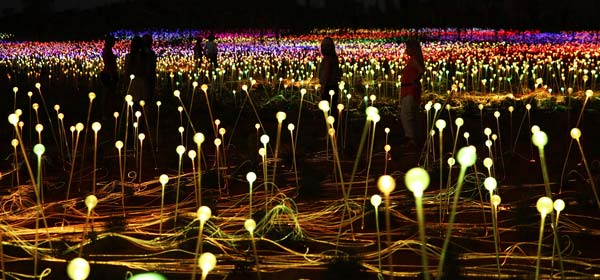I was told by those who have seen it that the Field of Light is a stand-out, once-in-a-lifetime travel moment. But even so, it has surpassed all my expectations.
It is the gentlest, prettiest, most inspiring sight I have ever seen.
Our visit starts with a 4.30am collection from the Desert Gardens Hotel at Ayers Rock Resort. We had been told the previous day, by an AAT Kings tour guide, that they are very careful to speak quietly on the sunrise tours as many guests do not like loud cheery chatter at that hour.
Image Credit: Field of Light, Uluru, Bruce Munro 2016. Photo by: Mark Pickthall
I’m one such guest, so I appreciate the quiet during our 15-minute drive towards Uluru, when we are able to take in the desert landscape as revealed by our coach’s headlights.
As we disembark, we are given tiny red torches to make sure we can find our way along the paths. As it happens, they are discreetly, but well, lit, so I don’t need to use mine.
First up we gather at the base of the nearest sand dune while Richard, our AAT Kings Ambassador, briefs us on the safety needs, timelines and what we can expect to see.
Image Credit: Field of Light, Uluru, Bruce Munro 2016. Photo by: Mark Pickthall
But nothing can prepare us for the wave of tiny, vibrant explosions of colour that undulate before us as we reach the top of the dune. There, in a vast stretch of darkness, shine 50,000 colour-filled flowers, seemingly bowing and swaying in front of a majestic, immovable Uluru.
Image Credit: Field of Light, Uluru, Bruce Munro 2016. Photo by: Mark Pickthall
Are they paying homage to this ancient spiritual monolith? Are they dancing in the moonlight? Or are they trying to convey a multitude of desert stories?
All of the above, and more. The genesis of this extraordinary sight was the vision of one man, Bruce Munro, an English immigrant to Australia in the early 1990s. In particular, he was struck by the sheer joy he experienced in the Red Centre. About 24 years ago, he dreamed of a field of light in front of what was then known as Ayers Rock. In the intervening years, he returned to work in the UK and elsewhere, establishing more modest versions of his frosted globe installations in Wiltshire, UK and Arizona, USA.
Image Credit: Field of Light, Uluru, Bruce Munro 2016. Photo by: Mark Pickthall
Finally, he was granted permission by the traditional owners of Uluru, the Anangu people, to bring his dream to life. And in March 2016 he and a team of colleagues painstakingly laid out the cabling and solar panels, and inserted the rods (stems) and frosted bulbs required to paint a neon representation of Australia’s ancient central desert, its seasons, vegetation and creatures. The Field of Light titled Tili Wiru Tjuta Nyakutjaku (which means ‘looking at lots of beautiful lights’ in local Pitjantjatjara), opened to rapturous reviews on 1 April 2016.
Image Credit: Field of Light, Uluru, Bruce Munro 2016. Photo by: Mark Pickthall
Since then many thousands of visitors have journeyed to Uluru and walked the red sand pathways in silent contemplation, marvelling at Mr Munro’s work. As we set off on our 60-minute stroll through the lights, Richard reminds us that this is our time to be silent; to look, listen and wonder.
And in the warm dawn air, this is what we do, an occasional burst of bird song the only sound to break the silence. Bruce Munro’s Field of Light offers peace, tranquillity, beauty and joy, in the most majestic of settings. Something each and every one of us deserves at least once in a lifetime, surely?
Image Credit: Field of Light, Uluru, Bruce Munro 2016. Photo by: Mark Pickthall
Don’t miss
After your walk, you can enjoy a tea or coffee from a viewing point, watching the globes dim as the sun rises.
Need to know
The AAT Kings tour lasts two hours. Single tour prices are $69 and $62 (concession). Book here At the time of writing, the Field of Light has just been extended until December 2020 – so add it to your list today.
Download your free Australian Travel Inspirations 2018 eGuide or view our eGuide!
Related articles:
Must-do experiences around Darwin
Six great reasons to visit South Australia
Australia’s coolest city

